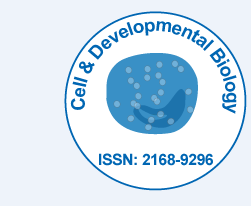
Cell & Developmental Biology
Open Access
ISSN: 2168-9296

ISSN: 2168-9296
Short Communication - (2025)Volume 14, Issue 1
Mitochondrial dynamics and metabolic programming plays key role in early embryonic development, regulating cellular energy production, biosynthetic processes, and signaling pathways that control cell fate decisions. The unique metabolic requirements of rapidly dividing embryonic cells, combined with the need for precise spatial and temporal control of cellular functions, make mitochondrial biology a central aspect of developmental biology [1]. Recent advances in metabolomics, live-cell imaging, and mitochondrial genetics have revealed the sophisticated mechanisms by which mitochondrial dynamics and metabolism regulate embryonic development [2].
Mitochondrial dynamics encompass the processes of mitochondrial fusion, fission, and transport that collectively regulate mitochondrial morphology, distribution, and function. The mitochondrial fusion machinery includes the outer membrane GTPases Mitofusin 1 (Mfn1) and Mitofusin 2 (Mfn2) which mediate outer membrane fusion, and the inner membrane GTPase Optic Atrophy 1 (OPA1), which mediates inner membrane fusion [3]. Mitochondrial fission is primarily controlled by Dynamin-related Protein 1 (Drp1), which is isDrp1 recruited to mitochondria by adaptor proteins such as Mitochondrial fission factor (Mff) and Fission 1 (Fis1). The balance between fusion and fission determines mitochondrial morphology and has profound effects on mitochondrial function and cellular metabolism [4].
The metabolic reprogramming that occurs during early embryonic development involves dramatic changes in energy production pathways, biosynthetic processes, and metabolic flux distributions. Mature oocytes and early embryos exhibit unique metabolic characteristics, including high glycolytic activity, reduced oxidative phosphorylation, and altered amino acid metabolism. This metabolic state supports the rapid cell divisions and biosynthetic demands of early development while maintaining cellular pluripotency. The transition from maternal to zygotic gene expression involves coordinated changes in metabolic enzyme expression and mitochondrial biogenesis that reshape cellular metabolism [5].
Mitochondrial inheritance and the establishment of mitochondrial DNA (mtDNA) copy number represent critical aspects of early embryonic development. Mammalian embryos inherit mitochondria exclusively from the maternal lineage, with paternal mitochondria being actively eliminated during early development. The mtDNA copy number undergoes dramatic changes during embryogenesis, with a significant reduction during early cleavage stages followed by expansion during implantation and organogenesis. This regulation of mtDNA copy number is essential for proper embryonic development and is controlled by factors including Transcription Factor A, Mitochondrial (TFAM) and DNA Polymerase Gamma (POLG) [6].
The metabolic control of cell fate decisions represents an emerging area of research that highlights the intimate connection between metabolism and development. Different cell types and developmental stages exhibit distinct metabolic profiles that both reflect and regulate their functional states. Pluripotent stem cells rely heavily on glycolysis and exhibit reduced mitochondrial oxidative capacity, while differentiated cells typically show increased oxidative phosphorylation [7]. This metabolic transition during differentiation is regulated by transcriptional programs that coordinate changes in metabolic enzyme expression and mitochondrial biogenesis [8].
Mitochondrial quality control mechanisms are essential for maintaining cellular function during the metabolic demands of early development. The mitochondrial unfolded protein response (UPRmt) monitors mitochondrial protein homeostasis and activates protective responses when mitochondrial function is compromised. Mitophagy, the selective degradation of damaged mitochondria, ensures the maintenance of a healthy mitochondrial population. The PINK1-Parkin pathway plays a central role in mitophagy by recognizing depolarized mitochondria and targeting them for autophagic degradation. These quality control mechanisms are particularly important during the metabolic transitions that occur during development.
The spatial organization of mitochondria within cells undergoes dramatic changes during early embryogenesis and plays important roles in cellular function. Mitochondrial positioning is regulated by interactions with the cytoskeleton and molecular motors that transport mitochondria to specific cellular locations [9]. The asymmetric distribution of mitochondria can create local differences in ATP availability, calcium buffering capacity, and reactive oxygen species production [10]. These spatial aspects of mitochondrial biology may contribute to the establishment of cellular polarity and asymmetric cell divisions that are crucial for embryonic development.
Calcium signaling represents a critical link between mitochondrial dynamics and embryonic development. Mitochondria serve as important calcium buffers, taking up calcium through the mitochondrial calcium uniporter and releasing it through the sodium-calcium exchanger. The spatial organization of mitochondria influences local calcium dynamics and can create calcium microdomains that regulate specific cellular processes. Calcium-dependent signaling pathways control numerous aspects of embryonic development, including cell migration, differentiation, and apoptosis.
[Crossref] [Google Scholar] [PubMed]
[Crossref] [Google Scholar] [PubMed]
[Crossref] [Google Scholar] [PubMed]
[Crossref] [Google Scholar] [PubMed]
[Crossref] [Google Scholar] [PubMed]
[Crossref] [Google Scholar] [PubMed]
[Crossref] [Google Scholar] [PubMed]
[Crossref] [Google Scholar] [PubMed]
[Crossref] [Google Scholar] [PubMed]
[Crossref] [Google Scholar] [PubMed]
Citation: Pablo L (2025). Mitochondrial Dynamics and Metabolic Programming in Early Embryogenesis. Cell Dev Biol. 14:390.
Received: 03-Mar-2025, Manuscript No. CDB-25-38138; Editor assigned: 05-Mar-2025, Pre QC No. CDB-25-38138 (PQ); Reviewed: 19-Mar-2025, QC No. CDB-25-38138; Revised: 26-Mar-2025, Manuscript No. CDB-25-38138 (R); Published: 02-Apr-2025 , DOI: 10.35248/2168-9296.25.14.390
Copyright: © 2025 Pablo L. This is an open-access article distributed under the terms of the Creative Commons Attribution License, which permits unrestricted use, distribution, and reproduction in any medium, provided the original author and source are credited.